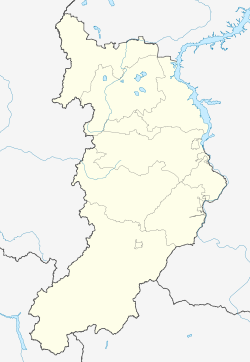Abakan
Abakan
Абакан | |
|---|---|
| Other transcription(s) | |
| • Khakas | Ағбан |
 Abakan Cathedral of the Transfiguration (Преображенский собор) | |
| Coordinates: 53°43′N 91°25′E / 53.717°N 91.417°E | |
| Country | Russia |
| Federal subject | Khakassia |
| Founded | 1675 |
| Government | |
| • Body | Abakan City Council of Deputies |
| • Head | Nikolay Bulakin |
| Area | |
| • Total | 259 km2 (100 sq mi) |
| Elevation | 245 m (804 ft) |
| Population | |
| • Estimate (2018)[1] | 184,168 |
| • Capital of | Republic of Khakassia |
| • Urban okrug | Abakan Urban Okrug |
| Time zone | UTC+7 (MSK+4 |
| Postal code(s)[3] | 655000 |
| Dialing code(s) | +7 3902 |
| OKTMO ID | 95701000001 |
| Website | abakan |

Abakan (Template:Lang-ru; Khakas: Ағбан) is the capital city of the Republic of Khakassia in Russia. It is located in the central part of Minusinsk Depression, at the confluence of the Yenisei and Abakan Rivers, at approximately the same latitude as Hamburg and Minsk. Population: 165,197 (2002 Census);[4] 159,000 (1994 est.).
History
Abakan stockaded town (Абаканский острог) was built at this location in 1675, also known as Abakansk. In the Russian Empire, it was a part of Yeniseysk Governorate. During 1823–1931 the grown settlement was known as Ust-Abakanskoye, 1914–1925: Abakan, 1925–1931: Khakassk. It received the status of town and its current name in 1931.
Chinese exiles
In 1940, Russian construction workers found ancient ruins during the construction of a highway between Abakan and the nearby district center village of Askyz (Аскыз). When the site was excavated by Soviet archaeologists during 1941-45, they realized that they had discovered a building absolutely unique for the area: a large (1500 square meters) Chinese-style, likely Han Dynasty era palace. The identity of the high-ranking personage who lived luxuriously in Chinese style, far outside of the borders of the Han Empire, has remained a matter for discussion ever since. Russian archaeologist L.A. Evtyukhova surmised, based on circumstancial evidence, that the palace may have been the residence of Li Ling, a Chinese general who had been defeated by the Xiongnu in 99 BC, and defected to them as a result.[5] While this opinion has remained popular, other views have been expressed as well. More recently, for example, it was claimed by A.A. Kovalyov as the residence of Lu Fang (盧芳), a Han throne pretender from the Guangwu era.[6]
Lithuanian exiles
In the late eighteenth and during the nineteenth century, Lithuanian participants in the 1794, 1830–1831, and 1863 rebellions against the Russian czarist rule were exiled to Abakan. A group of camps was established, and prisoners were forced to work in the coal mines. After Stalin's death, Lithuanian exiles from the nearby settlements moved in[7]
Economy
Abakan (together with Tayshet) was a terminal of the major Abakan-Taishet Railway. Now it is an important railway junction.
The city is served by the Abakan International Airport.
The city has a river port, industry enterprises, Katanov State University of Khakasia, and three theatres. Furthermore, it has a commercial center that produces footwear, foodstuffs, and metal products.
The 100th Air Assault Brigade of the Russian Airborne Troops was based in the city until c.1996. (Schofield, The Russian Elite)
Sites
Abakan's sites of interest include Holy Transfiguration Cathedral, "Good Angel of Peace" sculpture, park of topiary art, and many others.
Sports
Bandy is the biggest sport in the city. Sayany-Khakasiya[8] have played in the highest division of Russian Bandy League for a long time. Last season they played in the 2nd highest division.
References
- ^ "26. Численность постоянного населения Российской Федерации по муниципальным образованиям на 1 января 2018 года". Federal State Statistics Service. Retrieved 23 January 2019.
- ^ "Об исчислении времени". Официальный интернет-портал правовой информации (in Russian). 3 June 2011. Retrieved 19 January 2019.
- ^ Почта России. Информационно-вычислительный центр ОАСУ РПО. (Russian Post). Поиск объектов почтовой связи (Postal Objects Search) (in Russian)
- ^ Federal State Statistics Service (21 May 2004). Численность населения России, субъектов Российской Федерации в составе федеральных округов, районов, городских поселений, сельских населённых пунктов – районных центров и сельских населённых пунктов с населением 3 тысячи и более человек [Population of Russia, Its Federal Districts, Federal Subjects, Districts, Urban Localities, Rural Localities—Administrative Centers, and Rural Localities with Population of Over 3,000] (XLS). Всероссийская перепись населения 2002 года [All-Russia Population Census of 2002] (in Russian).
- ^ L.A. Evtyukhova (Л.А. Евтюхова), Southern Siberia in Ancient Times Южная Сибирь в древности). In: "Tracing Ancient Cultures between the Volga and the Pacific" (По следам древних культур: от Волги до Тихого Океана). Moscow, 1954, pp. 195-224.
- ^ A.A. Kovalyov (А.А. Ковалёв), Chinese Emperor on the Yenisy? Once more about the owner of the Tashebik "Palace" (Китайский император на Енисее? Ещё раз о хозяине ташебинского «дворца»), in "Ethnohistory and archaeoilogy of Northern Eurasia: theory, methodology, and the recearch practice" ("Этноистория и археология Северной Евразии: теория, методология и практика исследования"). Irkutsk, 2007, pp. 145-148.
- ^ Abakanas. Aldona Juodvalkytė. Visuotinė lietuvių enciklopedija, I t. Vilnius: Science and encyclopedias publishing institute, 2001. T.1: A-Ar.
- ^ http://www.sk19.ru/
External links
- Template:Ru icon Abakan web portal
- Template:En icon Abakan live cam
- Template:En icon Abakan city streets views
- Template:Tr icon [1] Beyaz Arif Akbas, "Khakassia: The Lost Land", Portland State Center for Turkish Studies, 2007.






